As a teen growing up on a steady diet of books, movies, and video games, there was always a certain character dynamic I gravitated toward hard, even though it was an embarrassingly long time before I could pinpoint what exactly it was about it that pushed my buttons so relentlessly. Turns out the answer is simple, even if it’s hard to find: a pure friendship between characters of different genders. Not a friendship that turns into a romance. Not a friendship that exists as a consolation prize for a failed romance or the rejected third of a love triangle. A friendship.
I think where I first came across this was in the movie Aliens, which I saw at the impressionable age of maybe twelve. There was so much I loved about that movie, but the extremely understated relationship between two minor characters—Vasquez and Drake—is what stuck with me. I’m sure a lot of people have shipped them as a couple, but to me their relationship was exactly how it’s shown (albeit minimally) on-screen. They’ve got each other’s backs. They’ve clearly Seen Some Shit™ together. She has to be bodily restrained from diving headlong into certain death-by-xenomorph to rescue him. In short, they’re war buddies. But it’s so rare to see that kind of intimate camaraderie between genders in fiction. Between men: absolutely. (War movies, sports movies, and military SF are full to bursting with them.) Between women: hell yes. (So many all-women found families to choose from. Two of my favorite examples are graphic novel runs: Lumberjanes, which is all-ages, and Rat Queens, which is…not.) But a mixed gender friendship that doesn’t turn into romance? Especially when we’re not being explicitly told that the possibility of romance and/or sex is not an option because one or both characters’ sexualities preclude it? They are ridiculously hard to find.
So, of course, this is the kind of relationship I write into pretty much all my books. Everything I do is about found families and close friendships and the recasting of romance tropes to center intense friendships instead (to date I’ve written slow-burn enemies-to-besties, a friendship triangle, and a hopeless obsessive platonic crush). Because if you can’t find it, write it, you know? Because someone else probably needs that book just as much as you do.
Buy the Book
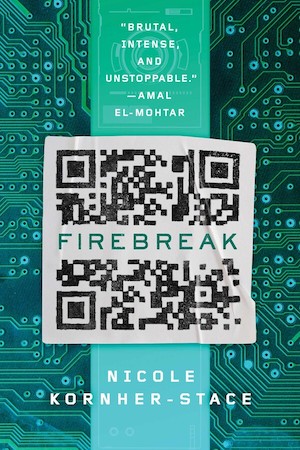

Firebreak
Lucky for me (and now for you), in the course of yelling my head off on Twitter about how badly we need more of these books in the world—not only for aro/ace representation, which I love to see, but also for everyone who values friendship and is tired of the prevalence of “just friends” and “friendzoned” (ugh) in both fiction and the real world, which fiction informs—people have recommended me some.
Here are a few.
Inscape by Louise Carey
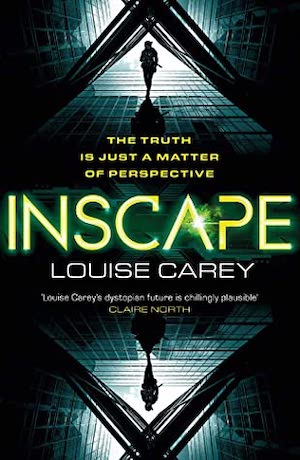
This novel is an absolutely kickass SF cyberpunk techno-thriller that deals with a whole heap of tropes that are catnip to me personally: Black Mirror-esque scary tech, corporate overreach that’s so overreach-y that it’s become the taken-for-granted status quo (they literally own people), child supersoldiers, etc. (Seriously, if you enjoyed any of those in my books, give this one a read, like, yesterday.) It follows Tanta, a soldier owned by the corporation that raised her from childhood, and Cole, a corporate employee with a mysterious past, as they uncover secrets about the company they work for. It’s exactly my kind of thing. But I heard of it because one day out of nowhere people were sending me the link to an interview with the author. I wasn’t sure why multiple people were making sure I saw it, but then I got to the part where Carey says: “Right from the start of planning Inscape, I was interested in exploring a platonic friendship between a man and a woman, and making that the emotional core of the novel. I haven’t seen much focus on relationships like that in the fiction I read, so I wanted to write one myself. Sometimes, I feel like the default assumption in a lot of fiction is that if you throw a male lead and a female lead together, sexual chemistry will be the inevitable result. When I encounter that attitude in a story, I find it wearing, because there are so many other rich, complex and interesting ways for men and women to interact!” And then it made a lot of sense. Tanta and Cole are a delight. If you want to see a professional relationship/forced alliance turn into a friendship and not a romance (or if you, like me, lost your shit when Mako Mori and Raleigh did not kiss at the end of Pacific Rim), give Inscape a read for sure.
The Nameless City by Faith Erin Hicks
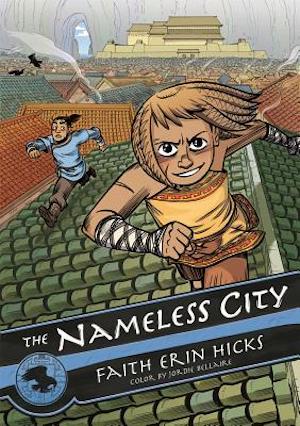
This is the all-ages, fantasy, sweeping epic graphic novel trilogy of your dreams. It’s about a city at war, named and renamed over the years by each invading army that conquers it, and the powderkeg tension between the latest invading force and the people who are just trying to survive in the city where they’ve always lived, no matter who’s flying their flag over it currently. The story follows Kaidu, a child of invaders, and Rat, whose parents were killed in the invasion. But it’s about the blossoming friendship between them, and over the course of three books they do not become a couple. This is maybe particularly stunning given their age—YA is crammed full of M/F friendships that pivot out of nowhere into romance for no apparent reason—but at any age Kaidu and Rat would still be a breath of fresh air. The concept art in the backs of the books is full of depictions of platonic intimacy (!!!) in which they are up in each other’s personal space in a way that is close as hell and yet never shown as romantic. At one point they’re holding hands! But we’re never told they’re anything but friends. (Bonus points here: they’re not friends because they’re not romantically/sexually compatible, at least not that we’re told. They’re friends because they enjoy each other’s friendship.) I do wish some of that concept art would have made it into the final story, but it’s in the books so it’s canon and I’m taking the win.
The Black Veins by Ashia Monet
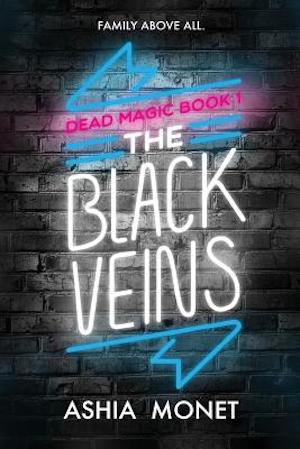
The Black Veins isn’t so much about a character pairing as it is about a found family of teens who really have to grow into each other’s friendship in order to go on a monster-slaying epic rescue road trip without annoying each other to death, and it’s very, very refreshing. On the surface the characters look like stereotypes—the Rich Girl, the Shy Boy, the Sarcastic Protagonist, the Hot Guy, etc.—but don’t fall for it! They’re all nuanced and wonderfully written with great character growth. If you’ve been looking for a Magical Teens in a Magical Society book that is written by an indie Black author instead of a zillionaire TERF and is full of all kinds of genuine character diversity and laugh-out-loud humor and queerness everywhere and just a ton of heart, this is the book for you. So many friendships among characters of all genders. Beyond one very flirty character who appears late in the story, there’s no hint of romance or sexual tension anywhere.
Collateral Damage by Taylor Simonds
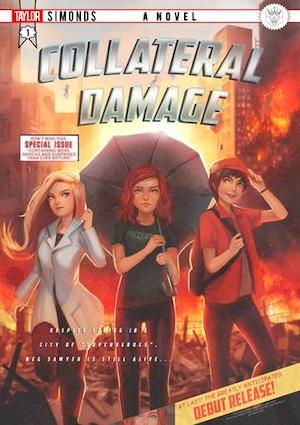
This is another found-family story, but the heart of it is the entirely adorable ride-or-die friendship between Meg and Oliver. They save each other’s lives more than once—I don’t want to spoil anything but they absolutely have each other’s backs amid Bad Shit, but they’re also a couple of goofy teenagers who hang out and watch bad movies while eating raw cake batter out of the bowl on the floor of Meg’s crappy apartment. With absolutely zero hint of romance, sexual tension, nothing. They’re best friends. Period. Even apart from their amazing friendship, this book is too much fun for its own good. It asks the question: sure, having superheroes watch over your city sounds cool, but what would that be actually like? And the answer is: awful. It would be awful. It’s like: what if The Boys, but wholesome. No, seriously. Read it.
Ninefox Gambit by Yoon Ha Lee
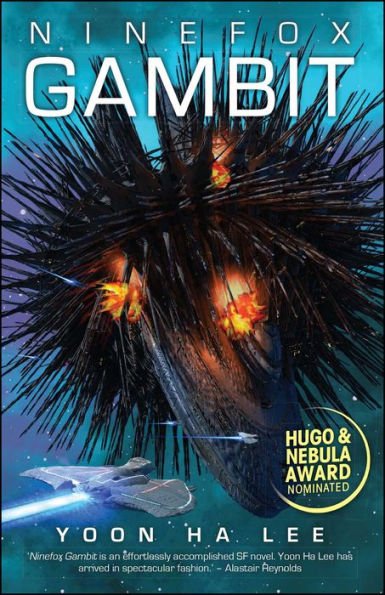
…Listen, I know what you’re thinking. But is it a friendship, Nicole. Is it really. And the answer is…maybe not? Not in the traditional sense anyway. Cheris and Jedao feel to me like Furiosa and Max in Fury Road, which is to say: an Unlikely Alliance, First Based on Necessity, Then Mutual Respect—and I could count on the fingers of one hand the number of fictional M/F relationships I can think of that didn’t start out like this and then turn into romance at the end. What made me absolutely want to include Ninefox Gambit on this list, though, is that you don’t get a whole lot more intimate than bodysharing, and that’s what Cheris and Jedao have to do. He literally lives in her mind. She casts his shadow. His reflection is in her mirror. The low-hanging plot fruit here would be to give this some kind of sexy vibe, but this absolutely does not happen and I adore every single micron of print in which it fails to occur.
Tell me about the ones I left out! I’d love to read them. And if you’re writing this type of character pairing, don’t listen to people who tell you your book “needs to” have a romance in order to be “relatable.” Real-world relationships have so much more variety than we tend to see depicted in our fiction, and it’s beyond time for fiction to catch up.
Nicole Kornher-Stace is the author of the Norton Award finalist Archivist Wasp and its sequel, Latchkey. Her short fiction has appeared in Clarkesworld, Apex, and Fantasy Magazine, as well as many anthologies. She lives in New Paltz, New York, with her family. She can be found online at her website, or on Twitter @WireWalking.










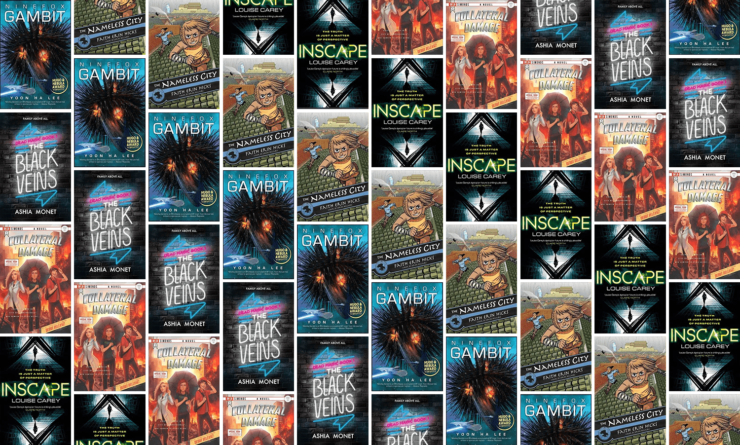
Harry Dresden and Chicago PD’s Karrin Murphy – attracted to each other but a very longstanding (dozen-plus books) relationship without romance based on trust and mutual support. Won’t spoil if there are changes in the most recent books. Bonus longstanding non-romance mutually dependent relationship – Harry with Molly Carpenter.
Edit – For those not fans, these are from the Dresden Files books by Jim Butcher.
Mat and Birgitte in the Wheel of Time series. A bromance for the ages.
@1 – Harry and Murphy is really not a great example. There was romantic/sexual tension in that relationship from the get-go. Harry and Molly is a good one, though I’m not sure if that’s really friendship. She’s his apprentice and she had a huge crush on him as well.
Houndstooth and Archie from Sarah Gailey’s American Hippo series!
Tamora Pierce’s books, in the Tortall and Emelan settings, heavily value friendship for people of any age and gender (and sapient species). They collectively feature a number of human m/f friendships that never become romantic or sexual, between adults and/or teenagers, though these are often not in the story’s foreground.
Ben S. Dobson’s Magebreakers series has a terrific friendship/partnership between a highly intelligent, somewhat obsessive male con man/detective and his female half-orc partner, who just loves life and magic and fights and pretty much everything she encounters. But (so far, anyway) no hint of romance or attraction. They have each other’s back big time, though.
One of the classic ones is Modesty Blaise and Willie Garvin of the Modesty Blaise books and comics.
I liked The Nameless City a lot. And I was also very pleased that Pacific Rim didn’t have to turn friendship into romance. I just now ordered a copy of The Black Veins. Might have to look for Inscape, though the sub-genres it represents do not usually appeal to me.
Commenting on another recent post with a similar focus, I mentioned that the best way I have found to say that another person and I are “just friends” without diminishing the importance of the relationship is to say “It’s sheer friendship.” Also without dissing sexual relationships, as might be implied by “it’s pure friendship.”
Halfteeth and Snacksize come as a pair in the Silver Kings books by Stephen Deas. They aren’t written as a couple, just as really good mates
@@.-@ – pushing back on your point just a bit. As I noted, H and K had mutual attraction issues from the get go but they put them aside and established a close working relationship and friendship over a LONG period of time in book years based on mutual respect and trust. So, I view them as a good example of the post’s theme.
@3 – Mat and Birgitte – absolutely.
Morgaine,and her faithful Nhi Vanye.
Daniel & Adele in Drake’s RCN space-opera series. They’re modeled on Patrick O’Brian’s Aubrey & Maturin.
Interspecies, for sure, but, I posit that the friendship between Esen-alit-Quar, or Esen, or “Es” to her friends – and Paul Ragem is about as close and very real a friendship as any friendship can be.
How about Fafhrd and the Gray Mouser? People don’t trust each other in Lankhmar – but these two do.
The TV series KILLJOYS features an outstanding example: the lead bounty hunter Dutch and her pilot Johnny Jaqobi. They have each other’s backs, even when Johnny is dubious about Dutch’s relationship with his brother. This isn’t Johnny protecting Dutch, just being realistic about both her and the brother’s personalities. KILLJOYS is hyperaction, with lots of gore as well as an exceptionally complex backstory.
Meg and Simon in ‘Written in Red’ by Anne Bishop are friends throughout the series, I don’t think there is any romance.
Having just read Ninefox Gambit, I am excited to read the rest of, as I like friendships that don’t turn into something more without a reason.
I immediately thought of Firefly’s Captain Mal Reynolds and his first officer Zoë Washburne. Had each other’s backs during war, still doing it on a freighter caught between making a living and dealing with fringe elements.
Zoe: “First rule of battle, little one … don’t ever let them know where you are.”
Mal: “WHOO-HOO! I’M RIGHT HERE! I’M RIGHT HERE! YOU WANT SOME O’ ME?! YEAH YOU DO! COME ON! COME ON! AAAAAH! Whoo-hoo!”
Zoe: “‘Course, there’re other schools of thought.”
Peter Grant and Sahra Guleed in Ben Aaronovitch’s Rivers of London series (about a secret police detective dept using magic in London and further out). Sahra Guleed first appears in the second book, Moon Over Soho, and her character is more fleshed out in subsequent novels and graphic novels. When she first appears, neither Sahra nor Peter, tho compatible re orientation, are in a relationship, but they are and remain purely platonic friends and also allies re being of a non-white ethnicity and working in the London Metropolitan Police Force.
Rowan and Bel in the Steerswoman series.
@14 – I also recommend reading the wonderful friendship between Esen and Paul, which can be enjoyed in the incredible Web Shifters books by Julie Czerneda. Their relationship is charming, funny, loving, and loyal. Also, these are my favorite books about aliens that truly feel alien.
I loved how E. K. Johnston subverted the romance expectation in The Story of Owen. The friendship between Siobhan and Owen is beautifully built.
Palamedes and Camilla in the Locked Tomb trilogy, Breq and Seivarden in the Ancillary trilogy (though both of them are genderless in their society, it feels applicable), Naomi and Amos in the Expanse.
Harry Potter and Hermione Granger! How did we miss that?
Finding books with friendships between male and female characters is a special joy and when I do find them, they’re very worth savoring.
Thank you for this article! You’ve added to my TBR pile … LOL.
Agents Coulson and May in “Agents of SHIELD”. Shown more as “brothers in arms” than a couple (each definitely shown with their own outside relationships, May even being married) though their shared experiences (and secrets) might be more intimate than most normal romantic couples.
Nita and Kit in “So You Want To Be A Wizard”, and the whole Young Wizards series, by Diane Duane. Admittedly the books start when the two young wizards are a bit young, thinking of each other as team-mates rather than as potential mates.
Captain Pausert and Goth in “The Witches of Karres” by James H Schmitz. Admittedly their ages make romance completely inappropriate, and the Captain continues to regard her like a “niece” even when Goth becomes confident that “in a few years” the situation will be very different.
re: Fafhrd and the Gray Mouser – they are DEFINITELY both male. When they first met, each had a girlfriend. The ensuing events, and their ongoing search for those responsible, is part of their brothers-in-arms bond.
re: the email comment about “romance wan’t happen because of orientation” – I hate to sound old fashioned, but reality is full of co-workers and colleagues who are NOT romantically involved; and there are lots of stories and movies about partnerships where both partners have other love interests, and even where the partners may well find each other attractive but don’t DO anything about it precisely for that reason. (See also the old song “Midnight Confessions” by the Grass Roots.)
@24: I think the author of the piece might consider that one beyond the pale, given the remark about zillionaire TERF
@12 CJ Cherryh’s Morgaine saga is one of my favorite series, and the protagonists are one of my favorite platonic couples.
The Rowan and her green sidekick Afra come to mind, too.
The friendship between Murderbot and ART is pretty special. Yes, neither is human, but that friendship seems pretty real, even with those star-chasing ups and downs
How is it no one before me mentioned Jack McDevitt’s Alex Benedict and Chase Kolpath from A Talent for War and the sequels?
Honor Harrington and the majority of the people in the Honorverse series. She’s a comrade in arms with nearly EVERYONE, male or female, whether they got along from the start or rubbed each other wrong and later grew respect. There’s Alistair McKeon from the first book, but later we meet all the people she comes to love including leaders of fleets and planets and religions and her own personal Armsmen who go with her to certain death and beyond; and in the whole sprawling series she only has romances with two people, neither of whom was a close battle buddy. Granted, while plenty of prominent people like Pritchard and Giscard or Zilwicki and Montaigne do hook up, there are plenty of platonic got-your-back friendships like Tomas Ramirez and Abigail Hearns to keep things business, not raging hormones, as you plow through really dense tech-speak and space opera physics and galactic politics.
@16 and @18 Killjoys and Firefly are awesome, super-entertaining examples on TV.
M. C. A. Hogarth’s Dreamhealers series has a soul bond between folks of two different species that’s specifically a platonic friendship and work partnership that isn’t lessened in any way when each of them finds other romantic and/or reproductive partners. Also her Conversations with the Ai -Naidar books get into some fascinating looks at a different culture’s relative priorities, one of which ranks ‘touch friends’ on par with reproductive bonds.
Agree regarding Harry and Hermione. One of my favorite themes in the Harry Potter series is the development and maturing of their friendship. JK Rowling managed to depict this perfectly.
Dhulyn and Parno from Violetta Malan’s stories.
@17 – Meg & Simon do develop a romantic relationship over the series. I liked the spin-off characters in Wild Country and I don’t remember a romance in that.
There are a lot of wonderful friendship stories but thinking of ones not prevented by age or orientation and without side romances is a surprisingly hard challenge!
Bujold’s first three Penric & Desdmona novellas are lovely and sans romance. Penric does acquire a love interest later and negotiating the impact of his relationship with his resident demon on a romance is itself interesting.
We Could Be Heroes by Mike Chen is about a man and a woman who each wake up with superpowers. They end up taking on a villain and hero role until they meet and realize they’ve got a lot more in common than they realized. It’s fantastic and all about a friendship.
I loved this post and my TBR pile grew, so thank you!